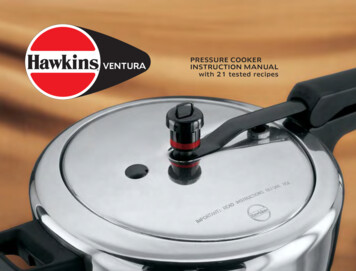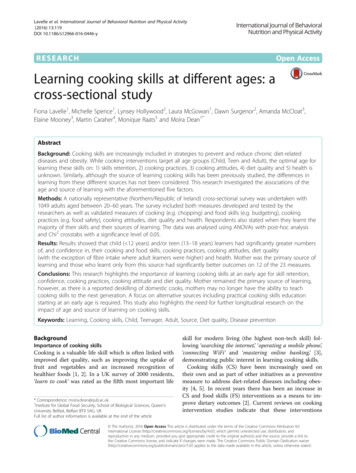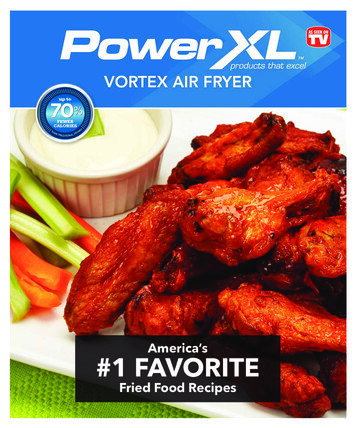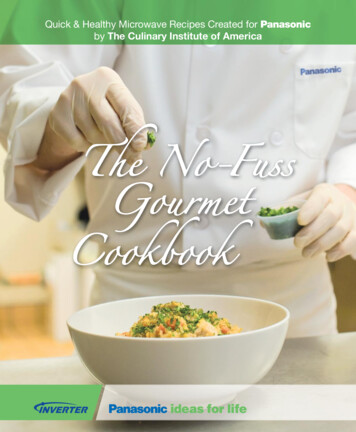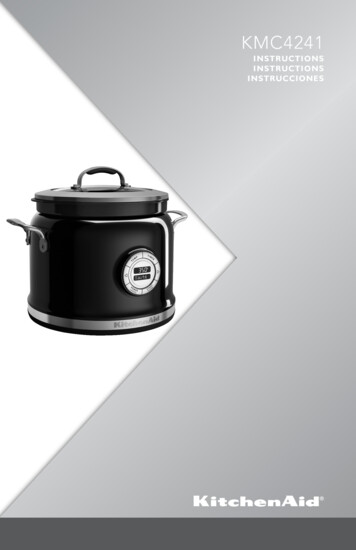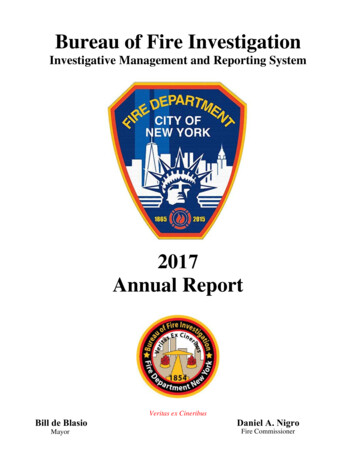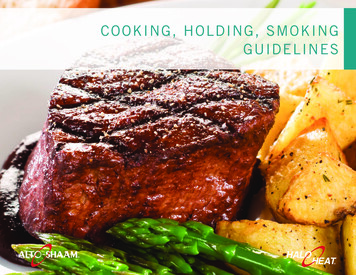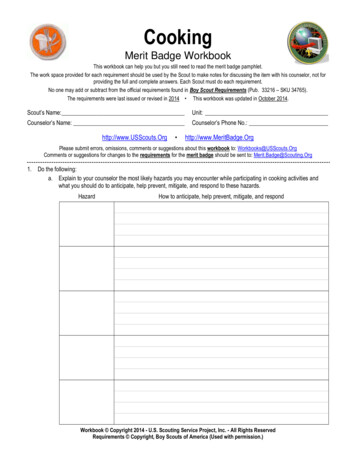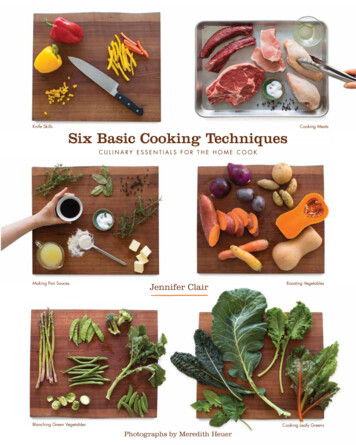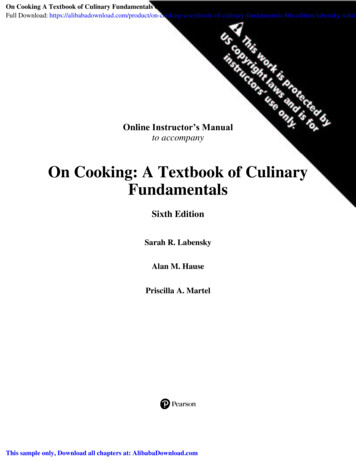
Transcription
On Cooking A Textbook of Culinary Fundamentals 6th Edition Labensky Solutions ManualFull Download: sky-solutiOnline Instructor’s Manualto accompanyOn Cooking: A Textbook of CulinaryFundamentalsSixth EditionSarah R. LabenskyAlan M. HausePriscilla A. MartelThis sample only, Download all chapters at: AlibabaDownload.com
Copyright 2019 Pearson Education, Inc. or its affiliates. All rights reserved. Manufactured in the United States ofAmerica. This publication is protected by Copyright, and permission should be obtained from the publisher prior toany prohibited reproduction, storage in a retrieval system, or transmission in any form or by any means, electronic,mechanical, photocopying, recording, or likewise. To obtain permission(s) to use material from this work, pleasesubmit a written request to Pearson Education, Inc., Permissions Department, 330 Hudson Street, New York, NewYork.Many of the designations by manufacturers and seller to distinguish their products are claimed as trademarks. Wherethose designations appear in this book, and the publisher was aware of a trademark claim, the designations have beenprinted in initial caps or all caps.10 9 8 7 6 5 4 3 2 1ISBN-13: 978-0-13-445365-1ISBN-10:0-13-445365-4
TABLE OF CONTENTSCHAPTERPAGE1 Professionalism12 Food Safety and Sanitation63 Nutrition104 Menus and Recipes145 Tools and Equipment206 Knife Skills267 Flavors and Flavorings308 Dairy Products439 Mise en Place4710 Principles of Cooking5111 Stocks and Sauces5812 Soups6613 Principles of Meat Cookery7014 Beef7415 Veal7816 Lamb8217 Pork8518 Poultry8819 Game9520 Fish and Shellfish9821 Eggs and Breakfast10622 Vegetables10923 Potatoes, Grains and Pasta11424 Healthy Cooking and Special Diets120
25 Salads and Salad Dressings12426 Fruits12827 Sandwiches13228 Charcuterie13529 Hors d’Oeuvre13930 Principles of the Bakeshop14231 Quick Breads14732 Yeast Breads15033 Pies, Pastries and Cookies15534 Cakes and Frostings15935 Custards, Creams, Frozen Desserts and Dessert Sauces16336 Plate Presentation16737 Buffet Presentation174
Chapter 1ProfessionalismChapter OverviewChefs and Restaurants, pp. 2-7Modern Food Service Operations, pp.7-11The Modern Kitchen Brigade, pp. 1113The Professional Chef, pp. 13-16The 18th Century–Boulanger’s Restaurant, pp.2-3The Early 19th Century–Carême and GrandeCuisine, p. 3The Late 19th Century–Escoffier and CuisineClassique, p. 4The Mid-20th Century–Point and NouvelleCuisine, p. 5The 20th and Early 21st Centuries–AnAmerican Culinary Revolution, p. 5Modernist Cuisine, p. 6Culinary Technologies, p. 7Food Supplies, p. 8Consumer Concerns, p. 9The Classic Kitchen Brigade, p. 12The Dining Room Brigade, p. 13Knowledge, pp. 13-14Skill, p. 14Taste, p. 14Judgment, p. 14Dedication, p. 15Professional Ethics, p.15Pride, p. 15Careers, p.15SidebarsMarie-Antoine (Antonin) Carême (1783-1833), p. 3Auguste Escoffier (1846-1935), p.4Ferdinand Point (1897-1955), p. 5Ferran Adrià (1962--), p. 7Chefs Work Toward a Sustainable Future, p. 11A Very Big Business Indeed, p. 9The Classic Kitchen Brigade, p. 12The Dining Room Brigade, p. 13La Toque Blanche, p. 14
Learning ObjectivesAfter studying this chapter, students will be able to: name key historical figures responsible for developing food serviceprofessionalism and describe the contributions of each (pp. 2-6) list and describe the key stages in the development of the modern food serviceindustry (pp. 6-13) explain the organization of classic and modern kitchen brigades (pp. 11-13) identify the attributes a student needs to become a successful culinaryprofessional (pp. 13-16) describe the importance of professional ethics for chefs and list the specificbehaviors that all culinary professions should follow (pp. 13-15)Key Termsapprenticesarea chefsassistantsback of the houseback waitersbrigadeCalifornia cuisinecaptainschefchef de cuisineclassic cuisinecookerycookingdining room managerethnic cuisineexecutive chefexpediterfarm-to-table movementfood servicefront of the housefront waitersfusion cuisinegastronomygenetically modifiedorganism (GMO)global cuisinegourmandgourmetgourmet foodsgrande cuisineheadwaiterinstitutional cookjudgementline cookmaster chefmaster bakermaster pastry chefmodernist cuisinemolecular gastronomynational cuisineNew American cuisinenouvelle cuisinepastry chefprofessional cookingregional cuisinerestaurateursshort-order cookskillsous-chefsustainable foodservicetastetoquewine stewardQuestions for Discussion, p. 161 Summarize the contributions that chefs Carême and Escoffier made to advance theculinary arts during the 19th century.Carême’s meal would feature showpieces, dozens of courses, foods that are elaboratelypresented, garnished and sauced. Point’s meal would be much lighter, emphasizing naturalflavors and simpler preparations.2 Discuss two recent culinary movements and their impact on the way food is served in
restaurants today.Fusion cuisine combines ingredients and preparations associated with one ethnic or regionalcuisine.Farm-to-table or locavore movement has influenced chefs to serve fresh seasonal foods andthose grown close to their establishmentsModernist cuisine movement or molecular gastronomy employs ingredients and machinery moretypical of food manufacturing into restaurant kitchens3. List and explain three technological advances affecting food preparation.Cast-iron stoves: the heat source could be approached, and the heat more easily controlledCanned foods: preservation and extended storageTransportation: increased availability, freedom from using only locally produced ingredients4 How can a food service operation address customer concerns about where their foodwas grown or raised and participate in the sustainability movement?Through such practices such as composting, recycling, reducing fuel consumption, biodegradable cleaning products, etc.5. Discuss the societal changes that have contributed to diversification in the modern foodservice industry.The creation and identification of new consumer groups; the increase in the type of facilitiesproviding food, such as schools, resorts, office complexes; the increase of women in theworkforce brought an increased need for food services and the financial means to use them.6. Describe the kitchen brigade system. What is its significance in today’s professionalkitchens?It is a system of staffing a kitchen. The executive chef leads the brigade, which includes souschefs, chefs de partie (station chefs) or area chefs and various assistants and apprentices. Thesystematic staffing and organization of personnel aids in efficient operation and avoids confusionand redundancy.7 What are the roles of a chef, sous-chef and line cook in a modern kitchen?The chef coordinates all kitchen activities, directs training, plans menus and sets the standards ofconduct. The sous-chef supervises and coordinates the preparation of foods. The line cooks aredirectly responsible for preparing food items as directed and may operate one or more stations,such as sauté and broiler.8 Describe the key attributes of a culinary professional and things you can do to developthe skills, taste and judgment required in your chosen career?Knowledge, skill, taste, judgment, dedication and pride are the key attributes of a culinaryprofessional. Knowledge and skill can be attained through schooling and apprenticeship. Taste
developed through experience and attention on the job. Judgement only comes throughexperience. Dedication comes through long hours of work and teamwork with colleagues. Joiningprofessional organizations helps chef demonstrate their dedication to the culinary professional.Pride is manifested by attention to detail in everything from personal grooming to wearing a cleanuniform each day on the job.9 List and explain the benefits that you can enjoy by belonging to a professional culinaryorganization.Professional organizations provide educational and networking opportunities. By joining suchassociations, chefs may find new job opportunities, new products and new ideas.10 Why do professional culinary organizations ask their members to adhere to a code ofethics?Answers vary. Ethics are a code of ways of doing things. The culinary code of ethics ensures thatall culinarians conduct themselves to the highest standards of honest, fairness and integrity.11. The James Beard Foundation recognizes and honors outstanding American chefs eachyear. Use outside sources to learn who was James Beard? Which chefs are currentlyconsidered some of the most outstanding in the United States? Why?www.jamesbeard.orgLearning ActivitiesDining TrendsAssign students a current restaurant food trend from this chapter (see pages 7-11) toresearch outside of class. Direct them to cookbooks, professional restaurant magazinesand culinary industry web sites to learn more about the trend. Industry resources such assurveys done by the market research firms as well as those consulted by food marketingorganization are also useful sources for this information.Each student will present a five-minute oral presentation that discusses a current exampleof this trend. Encourage students to plan their presentations creatively.http://www.restaurant.org The National Restaurant Association provides restaurant and foodtrend information to the industry.www.hartman-group.com/ provides research and consulting services to the foodservice and otherindustries.www.thepacker.com/ provides foodservice information to the fresh fruit and vegetable industry.Brigade de CuisineDuring class time, cluster students into groups of three or four to diagram on large piecesof butcher paper the appropriate staffing and stations for two contrasting food serviceoperations, such as:
Four-star restaurant/school cafeteriaCafé/retirement homeHotel/office complexBanquet hall/sports arenaEach group will then present its kitchen and staffing plan to the whole class, explainingits reasoning.Becoming a ChefIn class, discuss the variety of food-service careers and opportunities for professionaltraining and development. Assign students to research the education and training of amajor chef or culinary professional of their choice.Each student will create a one-page professional resumé of his or her chosen foodprofessional’s education, training and other credentials to post in the classroom.www.starchefs.com profiles some of the nation’s leading culinary figures.Professional Development PlanIn class, share with students some of the organizations and associations that offer support,training and scholarships to culinary professionals. Ask students to identify their personalcareer goals and write a one-page professional development plan for attaining them. Asan additional out of class activity, have students interview chefs in their area on whichprofessional culinary organizations they belong to and why.Sustainable FoodserviceIn class discuss with students the new trend of sustainable foodservice. Have studentsbreak into smaller groups to discuss and list 5 ways to protect their local environment.American Culinary Federation, Inc. is the site of the national professional organizationfor chefs.International Association of Culinary Professionals is the site of the internationalprofessional organization of culinary professionals.Women Chefs & Restaurateurs is the site of this organization devoted to promoting theeducation and advancement of women in the restaurant industry.National Restaurant Association hosts business-related information on the restaurantindustry.Supplementary MaterialsPowerPoint Slides
On Cooking A Textbook of Culinary Fundamentals 6th Edition Labensky Solutions ManualFull Download: sky-solutiChapter 2Food Safety and SanitationChapter OverviewSanitation, p. 18Direct Biological Contaminants, pp. 18-25Direct Chemical Contaminants, pp. 25-26Direct Physical Contaminants, p. 26Cross-Contamination, pp. 26-32Hazard Analysis Critical Control Points(HACCP) Systems, pp. 32-35Food Allergies and Intolerances, pp. 35-36The Safe Worker, pp. 36-37Bacteria, pp. 19-23Parasites, pp. 23-24Viruses, p. 24Funghi, p. 25Residual Chemicals, p. 25Food Service Chemicals, p. 26Toxic Metals, p. 26Personal Cleanliness, pp. 27-28Dish and Equipment Cleanliness, pp. 28-30Food Storage, p. 30-31Food Labeling, p. 31Pest Management, p. 31-32Personal Safety, p. 36-37Fire Safety, p. 37First Aid, p. 37SidebarsSafety Alert: FAT TOM, p. 21Safety Alert: The Temperature Danger Zone, p. 21Safety Alert: Time and Temperature Control for Safety (TCS) Food, p. 23Food Safety of Fruits and Vegetables, p. 25Steps to Prevent Cross-Contamination, p. 26Safety Alert: Tasting Food, p. 27Safety Alert: Single-Use Gloves, p. 27Sanitizing Solution, p. 30Safety Alert: Chemical Storage, p. 30Sustainable Food Safety, p. 31ObjectivesAfter studying this chapter, students will be able to: explain the importance of sanitation in the restaurant industry and identify thethree major types of contaminants that cause food-borne illnesses (pp. 18-35)This sample only, Download all chapters at: AlibabaDownload.com
culinary arts during the 19th century. Carême's meal would feature showpieces, dozens of courses, foods that are elaborately presented, garnished and sauced. Point's meal would be much lighter, emphasizing natural flavors and simpler preparations. 2 Discuss two recent culinary movements and their impact on the way food is served in
